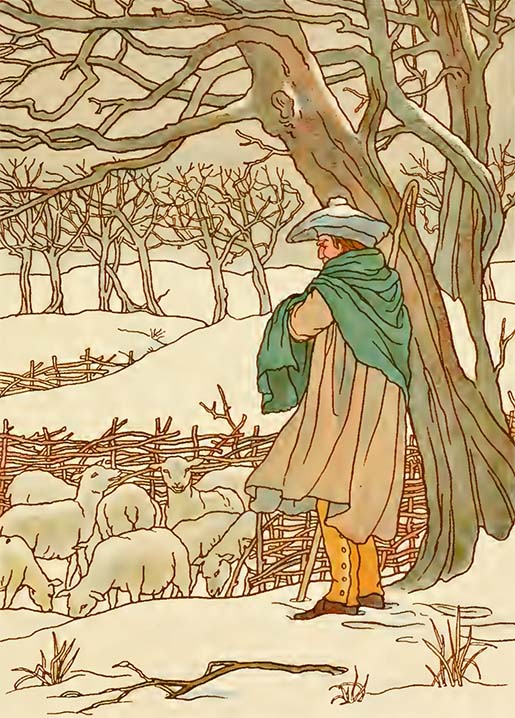Winter Song
When the trees are all bare, not a leaf to be seen,
And the meadows their beauty have lost;
When nature’s disrobed of her garment of green,
And the streams are fast bound by the frost;
When the shepherd stands idle and shivers with cold,
As bleak the winds northerly blow;
When the innocent flocks run for ease to the fold,
With their fleeces besprinkled with snow.

Full Version
When the trees are all bare, not a leaf to be seen,
And the meadows their beauty have lost;
When nature’s disrobed of her garment of green,
And the streams are fast bound by the frost;
When the shepherd stands idle and shivers with cold,
As bleak the winds northerly blow;
When the innocent flocks run for ease to the fold,
With their fleeces besprinkled with snow.
In the yard when the cattle are foddered with straw,
And they send forth their breath like a stream;
And the neat-looking dairymaid sees she must thaw
Flakes of ice that she finds in the cream.
Then the lads and the lasses in company join’d,
Round the fireplace gather in glee,
Talk of fairies and witches that ride on the wind,
And whistle and sing so do we.
Origin
Winter Song was printed in A Book of Nursery Songs and Rhymes (1895), edited by Sabine Baring-Gould and illustrated by F. D. Bedford. It appears immediately after Song of Spring as its seasonal counterpart. Baring-Gould noted in the book’s appendix that the verses are “two of an old English song… some 200 years old,” which means the rhyme was already traditional before it reached the nursery bookshelf. Earlier fragments also turn up in Halliwell’s collections and in The Garland of Country Songs.
Meaning
This rhyme is less a riddle or chant than a winter scene in verse. It paints the countryside in frost: bare trees, frozen rivers, sheep huddling for warmth, cattle steaming in the yard, and dairymaids breaking ice from cream. The second stanza shifts indoors, where villagers gather by the hearth, swapping stories of witches and fairies while singing together. The contrast is deliberate: the cold, harsh world outside and the warmth, comfort, and imagination found inside.
Cultural Background
Victorian compilers often mixed silly jingles with polished pastoral songs. Winter Song is one of the latter. Its rural detail would have been familiar to children in the 19th century, while its fireside imagery connects directly to folk storytelling traditions. Baring-Gould made clear that the song was older than his book, likely passed down through country singing before being smoothed into nursery form.
Together with Song of Spring, it forms a seasonal pair: one celebrates blooming meadows and cuckoos, the other captures frozen fields and winter hearths. Linking them shows how nursery books sometimes taught children to notice the rhythms of the natural year.

